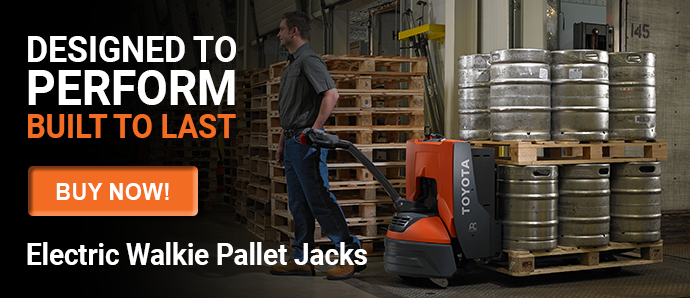Walkie Stackers vs. Forklifts: What’s the Difference?
by Adam Gavrun, on Feb 2, 2024 2:27:00 PM
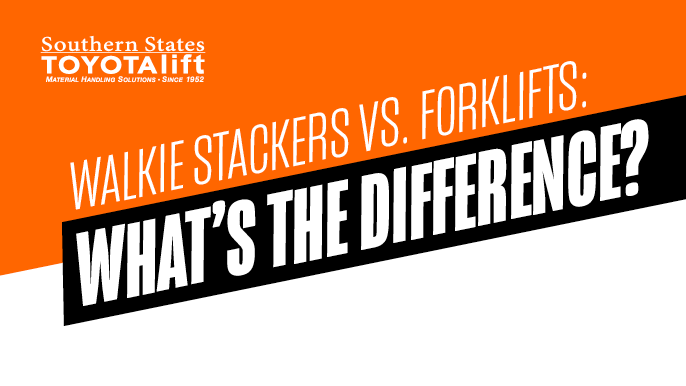
Forklifts are the most common solution for most material handling needs. Yet sometimes, you need the lifting height of a forklift but not its capacity. That's where walkie stackers come in. These machines offer an economical alternative to fork trucks while providing the power and lift to meet all your light-duty needs. Read on to learn the difference between stackers and forklifts, when to use one over the other, and the different types on the market.
What Is the Difference Between a Stacker and a Forklift?
Although you're unlikely to confuse them side by side, walkie stackers and forklifts have more in common than you might think. Both are considered powered industrial trucks by OSHA, can carry loads of a ton or more, and lift palletized material above floor level for shelving or racking storage. However, from there, the differences begin to stack up.
Forklifts
Forklifts are ride-in vehicles engineered to handle heavy palletized materials. They come in a wide range of types and, depending on the model, can lift loads ranging from 1 ton to more than 35 tons. Additionally, taller or extended masts allow some forklifts to achieve lifting heights up to more than 30 feet. Fork truck power can be electric or IC, and various models handle everything from indoor environments to rugged terrain. Due to their diversity and power, these machines are usually operated by facilities that move numerous heavy pallets throughout each shift.
Walkie Stackers
At first glance, an electric walkie stacker looks very similar to a pallet jack with a mast—this is why they are sometimes called pallet stackers. Indeed, a stacker fills a role halfway between a forklift and a pallet jack. These are typically walk-behind machines, which OSHA classifies as Class III powered industrial trucks. They allow the operator to move and lift pallets up to 4,000 lbs to heights of around 15 ft.
These machines are smaller than forklifts and more able to navigate narrow aisles. They are electrically powered and designed for indoor use. Their internal batteries require less infrastructure than electric forklifts and, thus, are easy to incorporate into most facilities.
When To Use a Stacker Instead of a Forklift
In some cases, the weight of a palleted product will require using a forklift. However, if your pallets fall below 4,000 lbs, a Toyota walkie stacker might make the most sense for your facility.
Stacker Pros
- Budget Friendly. Due to their small size and relative simplicity, stackers are a lower-cost alternative to forklifts. They're perfect for facilities that need a lifting solution that won't break the bank.
- Narrow Aisle Masters. Stackers have a narrow profile and tight turning radius compared to many forklifts. This makes them excellent choices for facilities that pack a lot of storage space into a small footprint.
- No Additional Infrastructure. Electric walkie stackers can be charged via a standard outlet. Most require no additional infrastructure, unlike forklifts, which require either battery chargers or refueling stations. This makes stackers ideal for facilities not ready to invest in the infrastructure to support a forklift.
Stacker Cons
- Low Power. Stackers do not have the raw power and lifting capacities of most counter-balance forklifts. This limits what materials they are suitable to transport.
- Lower Lifting Heights. Pallet stackers are more restricted in their lifting height than many forklifts. If your facility stores materials higher than 15 ft, a forklift would better serve you.
- Less Ergonomic. Walkies require the operator to walk behind the unit. Though the driving is power-assisted for most models, walking and standing for long periods is more fatiguing to your workforce than sitting in the driver's seat of a forklift.
Different Types of Stackers
There are four varieties of Toyota walkie stackers to consider when choosing a model for your facility.
Walkie Stackers
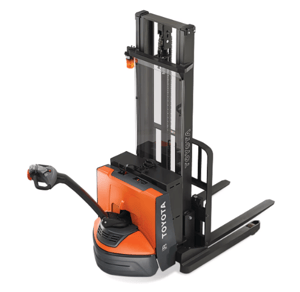 These are your typical light-duty models designed to be easy to use and cost-effective. They are best for short runs where pallets are lifted to second-tier racks and above. These units usually top out at 2,500 lbs of lift capacity. Quality models, such as Toyota's line, include AC drive motors with regenerative braking for smooth acceleration, safe stopping, and extended run times.
These are your typical light-duty models designed to be easy to use and cost-effective. They are best for short runs where pallets are lifted to second-tier racks and above. These units usually top out at 2,500 lbs of lift capacity. Quality models, such as Toyota's line, include AC drive motors with regenerative braking for smooth acceleration, safe stopping, and extended run times.
Counter-Balanced Stackers
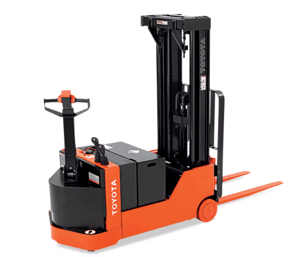 These are the closest thing to a mini-forklift. Because of their counter-balance system, they have lifting capacities of up to 4,000 lbs and lift heights of 15 feet. Additionally, they lack the base legs featured on other stackers. This makes them easier to maneuver in tight spaces. These features make counter-balance stackers an excellent alternative to standard forklifts.
These are the closest thing to a mini-forklift. Because of their counter-balance system, they have lifting capacities of up to 4,000 lbs and lift heights of 15 feet. Additionally, they lack the base legs featured on other stackers. This makes them easier to maneuver in tight spaces. These features make counter-balance stackers an excellent alternative to standard forklifts.
Industrial Walkie Stackers
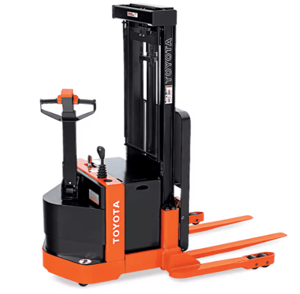 These pallet stackers are a middle ground between standard stackers and counter-balanced models. They have the lifting capacity of a counter-balanced stacker with the handling of a standard stacker. This makes industrial stackers highly durable and the top performer among stackers. This variety is your best choice if you want the most reliability during frequent use. However, the power these models provide requires a larger battery which may need a hard-wired charger in your facility. This variety is your best choice if you want the most reliability during frequent use.
These pallet stackers are a middle ground between standard stackers and counter-balanced models. They have the lifting capacity of a counter-balanced stacker with the handling of a standard stacker. This makes industrial stackers highly durable and the top performer among stackers. This variety is your best choice if you want the most reliability during frequent use. However, the power these models provide requires a larger battery which may need a hard-wired charger in your facility. This variety is your best choice if you want the most reliability during frequent use.
Walkie Reach Truck Stackers
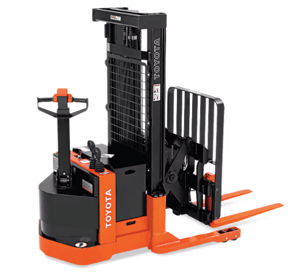 This kind of stacker can replace a reach truck forklift in many light-duty industries. It has all the functions of a standard stacker with the added ability to extend the forks into your racking. This allows easy access to the second row of pallets. Toyota's model has a lift capacity of up to 3,000 lbs, which makes for a powerful, mobile unit built for precision. However, the industrial batteries and extended base legs give these stackers a larger footprint. This makes them less able to navigate tight spaces and may require installing a hard-wired charger.
This kind of stacker can replace a reach truck forklift in many light-duty industries. It has all the functions of a standard stacker with the added ability to extend the forks into your racking. This allows easy access to the second row of pallets. Toyota's model has a lift capacity of up to 3,000 lbs, which makes for a powerful, mobile unit built for precision. However, the industrial batteries and extended base legs give these stackers a larger footprint. This makes them less able to navigate tight spaces and may require installing a hard-wired charger.
Make the Best Choice for Your Facility
Ultimately, the decision between a pallet stacker and a full-blown forklift must be based on your facility's material handling needs. Our Solutions Team has the expertise to evaluate your facility, process, and product to determine which option and model is best for you. If you’re considering investing in a stacker, contact our team today. To learn more about walkie stackers or to request a quote, contact us online or visit one of our locations throughout Georgia and Florida.
Florida
Jacksonville
Lakeland
Ocala
Orlando
Tampa
Winter Haven
Georgia
Albany
Macon
Columbus
Valdosta
Further Reading
How to Choose the Best Walkie Stacker for Your Warehouse
Why Do Safety Directors Love Walkie Stackers?
Is Your Pallet Jack Putting Your Staff at Risk?